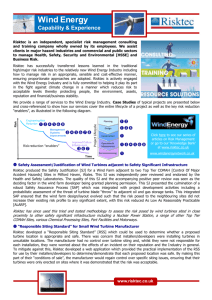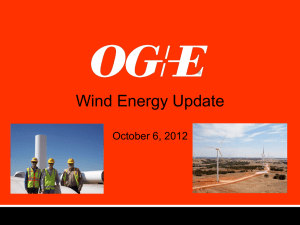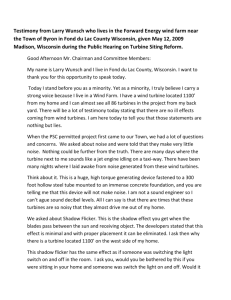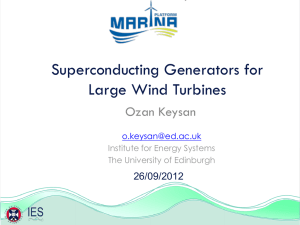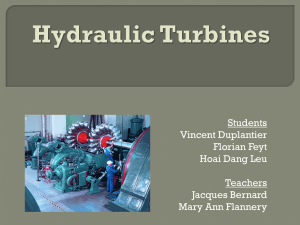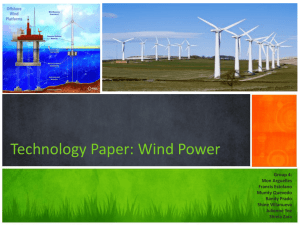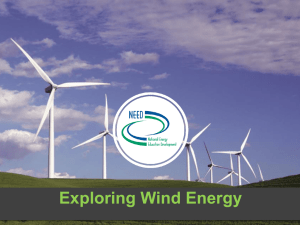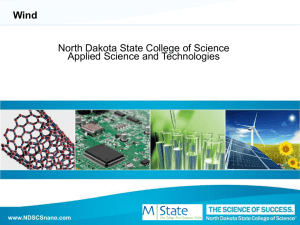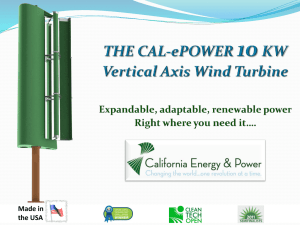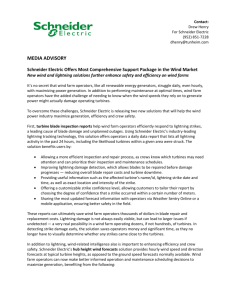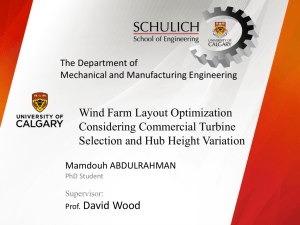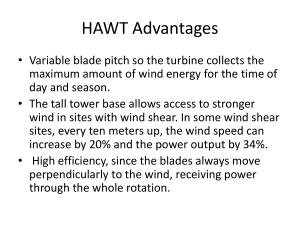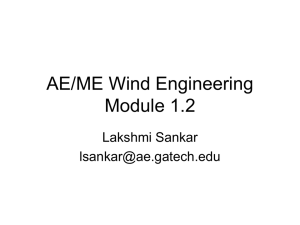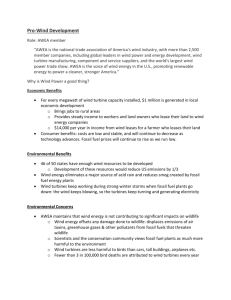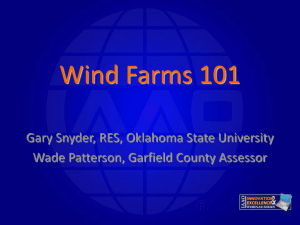19_Wind_Engineering
advertisement
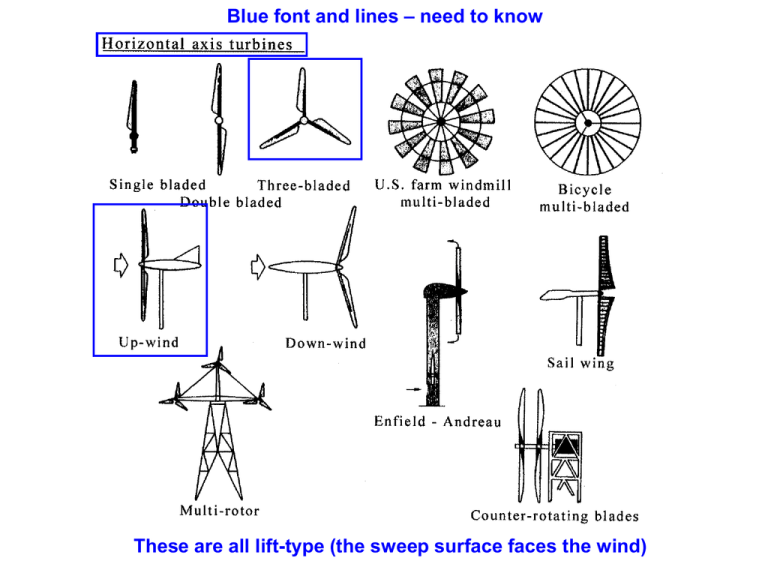
Blue font and lines – need to know These are all lift-type (the sweep surface faces the wind) These are suitable for utility-scale generation Too much interference from tower Not high enough above ground Drag-Type - not suitable for serious power Wind 4 m/s cut-in 12.5 m/s rated power 25 m/s cut out 56 Pmax region, pitch regulated to hold Pmax cubic 25 1 mile = 1609 m Desert Sky Wind Farm www.desertskywind.com Desert Sky Wind Farm - Map • Dallas - 400 Miles • San Antonio - 266 Miles • Odessa - 90 Miles • Ft. Stockton - 50 miles • McCamey - 20 Miles • Iraan - 12 Miles Desert Sky Wind Farm (approx 300 miles due west of Austin) At least 100 wind turbines in a wind farm 330 ft 215 ft Approx. 10 wind turbines (15 MW) per square mile. Thus, a farm needs at least 10 square miles. Metric units – about 6 MW per square km. 115 ft Operate at 10 – 20 RPM, with wind speed range 8 – 56 MPH Desert Sky Wind Farm • Commercial operation - Jan ‘02 • 160 MW Project • One hundred seven 1.5 MW turbines • 211 ft (65 meter) hub height • 229 ft (70.5 meter) rotor diameter • Total height of 329 ft (101 meters) to top of blade tip to base • Project occupies about 16 square miles • One substation with two transmission interconnects GE 1.5S Wind Turbine Operation • Operates in 8-56 mph wind speeds • Each turbine is a self-contained independent power plant, no operator intervention required • Onboard weather station, yaw control facing wind • Variable speed, operates from 1020 RPM rotor/blade assembly, generator speeds 850 to 1440 RPM Nacelle Layout Technical Talking Points *6 pole machine, Synchronous speed 1200 rpm. *Converter operation (Variable speed machines), Sub-synchronous/supersynchronous operation *Gearbox Operation (1:72 ratio) *Low Voltage ride through *Collection system/substation design *Transmission system issues (congestion) *Power Factor/ VAR control/Transmission system voltage control *Non-dispatchable nature of wind power/renewable energy systems in general *Climb assists O&M - Non-Routine Corrective Maintenance • Blade repairs, lightning damage & leading edge erosion. • Blade inspections and repairs are completed annually. • About 25 lightning related repairs per year. 25 lightning-related repairs per year per 100 turbines • Since commissioning, three blades have required replacement due to lightning damage. • Gearbox failures and subsequent replacement. • Gearbox life cycle appears to be 5-8 years. Note: The repairs mentioned above require two cranes, a large 300 ton crane and a smaller 100 ton crane. Crane availability and expense are serious issues facing wind farm owners. Demand for crane service is currently outpacing availability. x K .E. 1 2 mv , 2 P d K .E. 1 v 2 dm dt 2 dt P 1 2 dx 1 v A Av3 2 dt 2 Better performance when cold Ideal gas law, PV = nRT. P1V1 P2V2 T1 T2 For constant P, T2 V2 V1 T1 so as T↑, V ↑. As V ↑ , then ρ↓. Result is as T ↑ , then ρ↓. KT 273 .15 15 273 .15 K gAdz P( z ) P( z dz) A dP g dz P MW 103 RT MW = molecular weight R = gas constant T = degrees K dP gP MW 103 1.185 104 P dz RT P Poe 1.185 104 z Po = 1 atm, T = 15ºC, z meters oe 1.185 10 4 z o 1.225kg / m3 , KA Relative Air Density (Nominal 1.0 at Sea Level, 15 Deg C) 1.15 Sea Level 1.10 and about 0.1 per 30º C 1.05 Relative Air Density Drops about 0.1 per 1000m, 500 m 1.00 1000 m 0.95 1500m 0.90 2000 m 0.85 0.80 2500 m 0.75 3000 m 0.70 -20 -15 -10 -5 0 5 10 Temp - C 15 20 25 30 35 40 v H vo H o Variation of Wind Speed with Height above Ground vo , Ho: velocity and height at reference position, usually 10 meters above ground. 1 th 7 power law Betz Limit – Max theoretical turbine energy capture = 59.3% of swept area when downwind is slowed to 1/3rd of the upwind speed. swept Betz Limit – Max theoretical turbine energy capture = 59.3% of swept area when downwind is slowed to 1/3rd of the upwind speed. Tip Speed rotor(rad / sec) Rrotor(m) TSR vwind vwind (m / sec) Response from Roy Blackshear, Manager of Desert Sky Wind Farm • We reach rated power at about 12.5 m/s or 28 mph at an air density of 1.09, which was originally calculated as the year round average for this site. • When wind speeds exceed rated, i.e., >12.5 m/s, the blades pitch-regulate to maintain rated output and rotor speed at slightly over 20 rpm. • Turbines pitch blades out of the wind if 10 minute average wind speeds exceed 25 m/s or 56 mph, or wind speeds of > 28 m/s for 30 seconds, or storm gusts of 30 m/s or 67 mph. Roy Blackshear, cont. • Lower ambient temperatures in the winter increase the air density substantially, resulting in improved performance of about 5% on the coldest days. • In general, the change in performance is subtle and only apparent where ambient temperatures are very low, below freezing. From GE Wind Energy Basics Q. How much does a wind farm cost? A. The total cost will vary significantly based on site-specific conditions, permitting and construction requirements, and transportation constraints. In general wind power development can cost around $2 million per megawatt (MW) of generating capacity installed, including supporting infrastructure commonly referred to as Balance of Plant (BoP). Q. How big are wind turbines? A. The “tip height” of a GE 1.5 MW turbine is approximately 120 meters, which represents the total height of tower plus a blade in its highest vertical position. Moderate: 6.4 - 7 m/s Good: 7- 7.5 m/s Excellent: >7.5 m/s Wind Energy’s Potential Wind power accounted for about 42% of all new power generating capacity added in the US in 2008, representing one of the largest components of new capacity addition. Wind energy could supply about 20% of America's electricity, according to Battelle Pacific Northwest Laboratory, a federal research lab. Wind energy resources useful for generating electricity can be found in nearly every state. Wind is projected to deliver 33% of all new electricity generation capacity and provide electricity for 86 million Europeans by 2010. GE 1.5MW Turbines GE 2.5 MW Turbine Turbine Spacing. Rows are perpendicular to prevailing wind direction. Turbines are spaced about 3 top heights apart in the rows, with about 10 top heights between rows.

